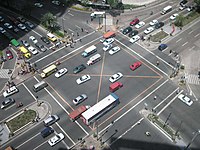
Photo from wikipedia
Crowded urban traffic is one of mankind’s greatest past, present, and future challenges, attracting interests from urban planning, urban geography, urban economics and other related disciplines. Although these fields provide… Click to show full abstract
Crowded urban traffic is one of mankind’s greatest past, present, and future challenges, attracting interests from urban planning, urban geography, urban economics and other related disciplines. Although these fields provide some insight into the problem, our understanding of the basic laws determining urban traffic systems’ evolutionary trajectory remains limited given that we do not fully understand the general co-evolutionary mechanisms underlying their complex dynamics. Therefore, a better understanding of the dynamics of urban traffic systems is necessary. The evolution of urban traffic systems appears to be accessible through mathematical descriptions, which involves land development, population, road and motor vehicle subsystems. In this paper, a four-level co-evolution dynamics model is developed to capture the growth trajectory of urban traffic systems. Our aim is to determine the driving force of urban traffic growth, the interactions among the studied subsystems, and whether the “disease” of urban crowding can be effectively predicted. Stability analysis indicates that this model is convergent. Taking two typical Chinese cities (Beijing and Shenzhen) as case studies, it is found that this model can be used to capture the observed co-evolution characteristics and to predict the future development of crowded urban traffic, thus benefitting all cities’ planning and control processes.
Journal Title: Nonlinear Dynamics
Year Published: 2019
Link to full text (if available)
Share on Social Media: Sign Up to like & get
recommendations!